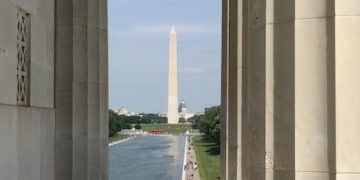Emergency Fed Meeting: Impact on US Economy Explained

An emergency Fed meeting can signal potential shifts in monetary policy due to unforeseen economic challenges, influencing interest rates, inflation, and overall stability of the US economy.
The announcement of an emergency Fed meeting has sent ripples across financial markets, sparking both concern and speculation about its implications for the **US economy**. What could be urgent enough to warrant such a meeting, and how might it affect your investments and financial well-being? Let’s delve into the potential scenarios and what they mean for you.
Emergency Fed Meeting Announced: Understanding the Context
An emergency meeting of the Federal Reserve, often referred to as the Fed, is a rare event. It typically indicates that the central bank perceives an urgent need to adjust monetary policy outside of its regularly scheduled meetings. These meetings are convened in response to unforeseen economic or financial developments that could significantly impact the US economy.
Understanding the possible catalysts for such a meeting and the potential outcomes is crucial for investors, businesses, and anyone concerned about the financial health of the nation.
Possible Triggers for an Emergency Meeting
Several factors could prompt the Fed to call an emergency meeting. These are often related to economic instability.
- Sudden Market Turmoil: A sharp and unexpected decline in the stock market or significant volatility in bond markets could trigger an emergency response.
- Financial System Shocks: The failure of a major financial institution or a credit crunch could necessitate immediate action to stabilize the financial system.
- Economic Data Surprises: Unexpectedly weak economic data, such as a significant drop in employment or a sharp contraction in GDP, might lead the Fed to reassess its policy stance.
- Global Economic Crises: Events in other countries that could have a large impact on the US economy and markets.
The Fed’s actions in these situations are aimed at mitigating risks and maintaining confidence in the economy.
In summary, an emergency Fed meeting signals heightened concern about the economic outlook, pushing the central bank to consider immediate policy adjustments.

Potential Actions the Fed Might Take
When the Fed convenes an emergency meeting, it has several tools at its disposal to address the perceived crisis. These actions are designed to influence interest rates, liquidity, and overall economic activity.
The specific measures taken depend on the nature of the economic challenge and the Fed’s assessment of the most effective way to respond.
Key Policy Tools
The Fed has a variety of policy tools to manage financial conditions.
- Interest Rate Adjustments: The Fed could lower the federal funds rate, the target rate that banks charge each other for overnight lending. This can stimulate borrowing and investment.
- Quantitative Easing (QE): The Fed might announce a program to purchase government bonds or other assets to inject liquidity into the market and lower long-term interest rates.
- Forward Guidance: Communicating the Fed’s intentions and outlook to the public can help manage expectations and reduce uncertainty.
These tools are used to influence borrowing costs, asset prices, and overall confidence in the economy.
The Fed could also use tools such as discount window lending and reserve requirements to deal with liquidity crunches. These are typically geared towards addressing issues in the banking system directly.
Historical Examples of Emergency Fed Meetings
Analyzing past emergency Fed meetings can provide insights into the types of situations that warrant such action and the typical policy responses.
Several historical episodes illustrate the Fed’s willingness to intervene aggressively during times of crisis.
Notable Emergency Meetings
Examining past meetings helps understand the range of possible Fed responses.
- October 2008: In the midst of the global financial crisis, the Fed coordinated with other central banks to cut interest rates in an attempt to stabilize financial markets.
- January 2001: Following the dot-com bubble burst, the Fed made an unscheduled rate cut to support the weakening economy.
- September 11, 2001: After the terrorist attacks, the Fed injected liquidity into the financial system to ensure smooth operations.
These examples show that the Fed acts decisively when faced with significant economic or financial shocks.
By studying these historical actions, one can see how the Fed attempts to navigate crisis situations.
The Immediate Impact on Financial Markets
The announcement of an emergency Fed meeting invariably leads to heightened volatility in financial markets. Investors react to the uncertainty surrounding the situation and the potential policy responses.
Equity markets, bond markets, and currency markets all experience increased price swings as traders try to anticipate the Fed’s next move.
Market Reactions
Here’s how different markets tend to react:
- Equity Markets: Stock prices often decline initially due to uncertainty, but a subsequent policy response, like a rate cut, can lead to a rebound.
- Bond Markets: Bond yields can fall as investors anticipate lower interest rates, increasing the demand for fixed-income securities.
- Currency Markets: The US dollar may weaken if the Fed signals a more accommodative monetary policy.
These immediate reactions can be amplified by algorithmic trading and investor sentiment.

Long-Term Implications for the US Economy
The long-term consequences of an emergency Fed action depend on the effectiveness of the policy response and the underlying strength of the US economy.
While immediate market reactions can be significant, the ultimate impact on economic growth, inflation, and employment is what truly matters.
Potential Economic Effects
Consider these potential longer-term outcomes:
- Stimulating Growth: Lower interest rates and increased liquidity can boost economic activity by encouraging borrowing, investment, and spending.
- Controlling Inflation: The Fed’s actions can influence inflation expectations and help keep price increases in check.
- Stabilizing the Financial System: By addressing systemic risks, the Fed can prevent a financial crisis from derailing the economy.
The Fed’s ability to navigate these challenges is crucial for long-term economic stability.
Any action will be weighed against the current data and the potential risks versus the rewards.
Expert Opinions and Economic Forecasts
Following the announcement of an emergency Fed meeting, economists and financial analysts offer their perspectives on the likely causes and potential consequences.
These expert opinions can provide valuable insights, although it’s important to remember that forecasts are not guarantees and should be viewed with caution.
Analyzing Expert Views
Different experts will provide different opinions.
- Consensus Forecasts: These represent the average of numerous economists’ predictions and can offer a general sense of the likely direction of the economy.
- Divergent Opinions: Some analysts may argue that the Fed is overreacting, while others may believe that more aggressive action is needed.
- Data-Driven Analysis: Experts often base their opinions on economic data, market indicators, and historical precedents.
A wide range of opinions should be researched before making any changes to financial strategies.
The value in expert opinion lies in their in depth knowledge that most consumers do not have the time to obtain.
How to Prepare for Economic Uncertainty
Given the potential for increased volatility and uncertainty following an emergency Fed meeting, it’s essential to take steps to protect your finances and investments.
Having a well-thought-out financial plan, diversification, and staying informed are key strategies for navigating turbulent times.
Strategies for Investors
Consider these actions:
- Diversify Investments: Spreading your investments across different asset classes can help reduce risk.
- Review Your Portfolio: Consider adjusting your asset allocation based on your risk tolerance and investment goals.
- Stay Informed: Keep up to date with economic developments and Fed policy announcements.
These are all actions that any investor can deploy when the market appears to be turbulent.
Ultimately, acting with a strategy is the difference between success and failure in the market.
| Key Point | Brief Description |
|---|---|
| 🚨 Emergency Meeting | Called due to unforeseen economic challenges. |
| 📈 Market Volatility | Expect increased price swings in stocks and bonds. |
| 🔑 Policy Tools | Rate cuts, QE, and forward guidance are possible. |
| 🛡️ Investor Prep | Diversify and stay informed to manage risk. |
Frequently Asked Questions
An emergency Fed meeting is an unscheduled gathering of the Federal Open Market Committee to address urgent economic or financial issues that require immediate action, outside of the regular meeting schedule.
The Fed calls an emergency meeting in response to situations such as sudden market turmoil, financial system shocks, or unexpected economic data that pose a significant threat to economic stability.
During an emergency meeting, the Fed can adjust interest rates, implement quantitative easing, provide forward guidance, or take other measures to inject liquidity and stabilize financial markets.
Financial markets often react with increased volatility as investors try to anticipate the Fed’s policy response. Stocks, bonds, and currencies can experience significant price swings.
Investors should diversify their portfolios, review their asset allocation, stay informed about economic developments, and consult with financial advisors to develop a plan that aligns with their risk tolerance and investment goals.
Conclusion
In conclusion, the announcement of an emergency Fed meeting serves as a critical signal of potential economic shifts, prompting investors and policymakers alike to closely monitor the situation and prepare for possible adjustments in monetary policy and market conditions. Vigilance and informed decision-making are essential during these times.





